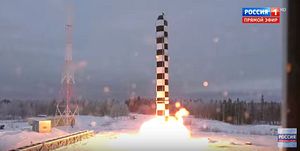The first regiment of Russia’s Strategic Rocket Force armed with the super-heavy thermonuclear-armed intercontinental-range ballistic missile (ICBM) RS-28 Sarmat (NATO designation: SS-X-30 Satan 2) is expected to deploy by 2021, according to a Russian defense industry source.
“Under the government-run program for armaments extending till 2027 Sarmat is to be produced serially starting from 2020. The first regiment armed with this missile is to enter duty in the Uzhur-based division [in 2021],” the source told state-run TASS news agency on March 2029. The Russian Ministry of Defense (MoD) has so far not publicly confirmed the deployment date.
The 62nd Missile Division (MD), currently deployed in Uzhur, is part of the 33rd Guards Missile Army, which is headquartered in Omsk in southwestern Siberia. According to the website Russian strategic nuclear forces, the 62nd MD is armed with 28 Soviet-era RS-36M2 Voyevoda (NATO designation: SS-18 Satan) ICBMs as of 2017.
According to the source, the regiment will first receive two RS-28 ICBMs, and is expected to deploy a total of six RS-28s. (Missile regiments consist of up to 10 missiles and around 400 military personnel.) The RS-36 — the current mainstay of Russia’s land-based ICBM force — will slowly be phased out beginning in the 2020s. The RS-36s are expected to stay in service until at least 2024, but their service life may be extended up to 2027 depending on the RS-28 induction schedule.
As I reported previously, the RS-28 program has encountered multiple delays and it is doubtful that the missile will be operational by 2021. Among other things, tests purportedly revealed deficiencies with the silo-based launchers. The first ejection test of the RS-28 took place in December 2017 at the Plesetsk space center.
Only one other test of the new ICBM occurred, according to publicly available information. “So far, we know of one single test of the new weapon system. In August 2016, the Sarmat’s first stage engine, named PDU-99, was tested. Analysts believe that the engine is a modified version of the RD-274 liquid rocket engine used on the RS-36M ICBMs. However, it is unclear whether the test was successful or not,” I reported in January 2017.
In a previous report, I described some of the missile’s technical characteristics:
The Sarmat can reportedly carry [around] 10 heavy lighter warheads. The new ICBM can allegedly also be fitted with a new [hypersonic boost-glide warhead], the YU-71, currently in development under the secret Project 4202. (…) The YU-71 is a warhead purportedly capable of penetrating any Western missile defense system. (…) Each warhead [allegedly] has an explosive yield of up to 750 kilotons.
Russian President Vladimir Putin revealed the existence of a new hypersonic boost-glide warhead, dubbed Avangard (Vanguard in English), during his annual State of the Union address on March 1, claiming that it had already entered serial production and will be ready for induction by 2019. Yet, as I explained: “[T]he U.S. intelligence community noted in 2017 that China’s HGV warhead, the DF-17, will be the first to see operational deployment anywhere, implicitly suggesting that the Avangard will probably not make the 2019 deployment.”
The RSS-28 will likely be fitted with three to five Avangard warheads.
































